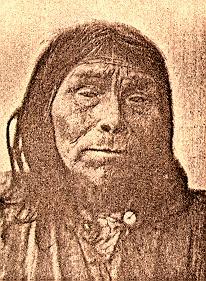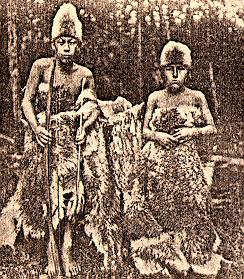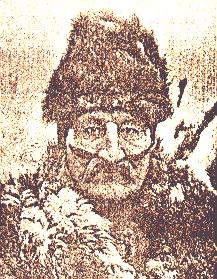|

Erich M. Von Hornbostel
The Music of the Fuegians
ETHNOS Vol. 13 Nos. 3-4, July 1948 
As an essential part of the most primitive Indian cultures the music of the Fuegians can claim particular interest. Considering the terrifyingly swift disappearance of just these tribes we may be doubly grateful for the fact that in the last moment clearsighted scholars have been able to take phonographic records of Fuegian songs, thus placing completely trustworthy material at the disposal of scientific research (Notations by Europeans of non-European music based upon direct hearing have with insignificant exceptions proved useless from the scientific point of view, and even the exceptions can only be acknowledged as such after phonograph control. It is as regrettable as it is hard to understand that up to this day even experts have not generally accepted this axiom). Colonel C. Wellington Furlong on his visit to Tierra del Fuego in the winter of 1907-1908 was the first to take about a dozen records of the songs of the Yámana (Yahgan) of Lauwi and Rio Douglas and the Selk'nam (Ona) of Najmish, Rio del Fuego and Puerto Harberton, copies of which were sent to the Berlin Archives for study. The publication of this study, although concluded, was withheld from print as Professor M. Gusinde in 1923-1924 increased the material so considerably- 31 phonographic records of the Yamana (in Puerto Mejillones), 7 of the Halakwulup (in Puerto Muñoz Gamero and Canal Smith) and 6 of the Selk'nam (in Puerto Remolino)- that in agreement with Colonel Furlong it was decided to postpone publication until conclusions had been drawn from the entire material. Thus the following discussions are based even upon Furlong's records.
Fig. 1. The Yamana woman Peine. Photo M. Gusinde
 |
Practically all the singers recorded were men, only in two of the profane songs of Calderon (nos. 24, 25) did some Yamana women join in and it took great persuasion to make the women Peine, fig. 1, and Gerty cooperate in recording the song accompanying the mourning recital (no. 22); only one of the Halakwulup songs (no. 32: fetching water) was performed by young Margarita. Selk'nam women sing only during the kloketen festival; they contributed with two phonographic records (nos. 43, 44). The singers were: with the Yamana Calderon (24, 26), Curty (13) and in certain animal dances even Crees -Calderon and Crees (Chris) had already been singing for Furlong's records - the medicine men (called yékamus) Tomas, fig. 2, (16, 20) and Pedro Masemikens (10, 14, 19); with the Halakwulup: Pedrito (31, 33, 36, 37) and Dalmacio (28, 29, 30, 34, 35); with the Selknam: Jose Hotex. Furlong's record no. 7 is a chorus sung by Yepenan David, Danushtunan Alfredo and Chris; no. 42 was probably performed by the medicine man Tinimisk (or more correctly Tenenesk), fig. 3.
Fig. 2. At the right the Yamana singer Tomas.. Photo M. Gusinde
 |
Great care has been taken when transcribing the phonographic records to musical notation. Every song was noted down by Dr M. Kolinski, most of them by Dr G. Herzog, quite independently from my own work; comparing the results afterwards helped to eliminate: the subjective deviations due to the European ear. I am most indebted to these gentlemen for their untiring and very valuable assistance. In order to study variants and define beginning and end of each stanza the whole phonographic record or at least a considerable part of it was transcribed wherever possible. For the musical appendix the clearest or most frequent, most "normal" variant was selected; important deviations in the repetitions have been marked by small notes or in brackets. We made use of the following diacritical, in our musical notation not customary signs: + or - above the note sharpens
Fig. 3. The Selk'nam singer Tenenesk. Photo M. Gusinde
 |
or flattens up to about a quartertone; constant deviations throughout a song being indicated in the beginning (as in nos. 19 and 20). A heavy line between two noteheads indicates glissando. v marks a breathing space,  shortens the note, both independently from the rhythm. shortens the note, both independently from the rhythm.
For easier comparison the songs have been transposed into the same range, with an endeavour to avoid signs if possible. Metronomic indications refer to the original tempo which could be reproduced by means of a normal a' recorded at the same time.
The features of singing are a characteristic of no less importance than the features of the songs themselves, yet they can only be recognized and compared with others by hearing the singers themselves or phonographic records. The manner of singing is decisive for the general impression of the listener. This no doubt holds particularly true concerning Fuegians, whose extraordinary talents of imitation and performance have been highly praised by all observers. This talent manifests itself in the animal dances of the canoe-faring tribes as well as in the mask plays of the Selk'nam. Realistic imitations are given of the characteristic poise and movement of animals - feeding, playing love games etc.- as well as of their sound utterings (The voices of the animals are not rendered by the singers, but by outstanders during the songs). Even the so-called spirits are characterized by mask and body painting, by poise and movement of the dancers and also by certain calls peculiar to various figures. Inevitably this strong tendency to characterize leaves its impact upon the songs, but it is not found where we usually find mimic "expression", in melody and rhythm. The musical style is so strongly bound by such traditions that it only allows very small differentations in melody.
In the case of animal dances tempo is probably adapted to the agility of the animal represented. Thus we find that the great mammals - H. 34: great deer, Y. 6: seal -have the slowest, small birds- H. 35, Y. 8 (?) -the swiftest tempi. It is also worth noting that different tribes give the same tempo to the same animal - Y. II, H. 37; and figures will agree even closer if the somewhat slower average rate of the Halakwulup is considered. (The average MM figure is 71 for the Halakwulup, 89,6 for the Yamana and 98,3 for the Selk'nam).
Besides tempo evidently also voice-quality and manner of delivery are used as means of characterization within the limits of these physiological -and hereditary- factors. But while phonographic records alone rarely suffice to reveal these more subtle differences, it is usually easy to recognize the characteristic "Indian" traits of the general impression. One has to hear them of course; it is almost impossible to convey a clear idea of them by enumerating their "elements" - partly we lack words to characterize these qualities, partly an analysis will always be apt to destroy just the essential factor contained in an undivided whole. Bearing this in mind we may describe Indian singing by such epithets as emphatic, pathetic, impressive, grave, solemn, dignified, weighty, stern, etc. Among the features responsible for this impression will be found strong accents, often further increased by audible expiration, on almost every crochet; a tendency to connect the notes by a portato and to subdivide lengthened notes by pulsations; the time being moderate or rather slow and remaining constant throughout the song.
Another basic feature are the "rhythmic accents" (see "Rhythm"). In the opinion of the writer the most important observation made already in connection with Furlong's phonographic records and definitely confirmed by Gusinde's recordings is this: The Selk'nam have the characteristic "emphatic" manner of delivery in common with all other Indians - including the Eskimo and certain Northern Asiatic tribes (Palaeoasiatics, Tungus) - while it is lacking with the Yamana and the Halakwup. On the other hand the songs of the canoe-faring tribes show the common Indian characteristics as fare as tempo and rhythm are concerned.
|
 INDEX: INDEX: |
|
|
|
|
|
|
|
|
|
|
|
|
|
|
|
|
|
HTML y diagramación: |
|



